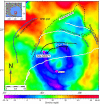Shaping of the Present-Day Deep Biosphere at Chicxulub by the Impact Catastrophe That Ended the Cretaceous
- PMID: 34248877
- PMCID: PMC8264514
- DOI: 10.3389/fmicb.2021.668240
Shaping of the Present-Day Deep Biosphere at Chicxulub by the Impact Catastrophe That Ended the Cretaceous
Abstract
We report on the effect of the end-Cretaceous impact event on the present-day deep microbial biosphere at the impact site. IODP-ICDP Expedition 364 drilled into the peak ring of the Chicxulub crater, México, allowing us to investigate the microbial communities within this structure. Increased cell biomass was found in the impact suevite, which was deposited within the first few hours of the Cenozoic, demonstrating that the impact produced a new lithological horizon that caused a long-term improvement in deep subsurface colonization potential. In the biologically impoverished granitic rocks, we observed increased cell abundances at impact-induced geological interfaces, that can be attributed to the nutritionally diverse substrates and/or elevated fluid flow. 16S rRNA gene amplicon sequencing revealed taxonomically distinct microbial communities in each crater lithology. These observations show that the impact caused geological deformation that continues to shape the deep subsurface biosphere at Chicxulub in the present day.
Keywords: chicxulub; craters; deep biosphere; drilling; impact crater.
Copyright © 2021 Cockell, Schaefer, Wuchter, Coolen, Grice, Schnieders, Morgan, Gulick, Wittmann, Lofi, Christeson, Kring, Whalen, Bralower, Osinski, Claeys, Kaskes, de Graaff, Déhais, Goderis, Hernandez Becerra, Nixon and IODP-ICDP Expedition 364 Scientists.
Conflict of interest statement
The authors declare that the research was conducted in the absence of any commercial or financial relationships that could be construed as a potential conflict of interest.
Figures







References
-
- Amend J. P., Teske A. (2004). Expanding frontiers in deep subsurface microbiology. Palaeogeo. Palaeoclimat. Palaeoecol. 219 131–155. 10.1016/b978-0-444-52019-7.50012-7 - DOI
-
- Bralower T. J., Cosmidis J., Heaney P. J., Kump L. R., Morgan J. V., Harper D. T., et al. (2020). Origin of a global carbonate layer deposited in the aftermath of the Cretaceous-Paleogene boundary impact. Earth Planet. Sci. Lett. 548:116476. 10.1016/j.epsl.2020.116476 - DOI
LinkOut - more resources
Full Text Sources

